NIEHS-supported studies add to all research and increase knowledge about cosmetic chemicals and potential harms.
Air Pollution and Your Health
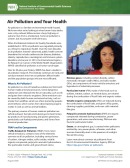
NIEHS is a leader in funding and conducting research on how air pollution affects health. The institute also studies the population groups who are most affected by air pollution.
Last Updated:
Arsenic and Your Health
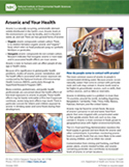
Arsenic is toxic to humans and can affect people of any age or health status. Arsenic levels in the environment can vary by locality, and it is found in water, air, and soil.
Last Updated:
Asbestos: Worker and Employer Guide to Hazards and Recommended Controls
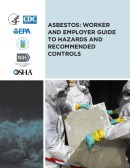
Asbestos is a mineral fiber that occurs in rock and soil. Because of its fiber strength and heat resistance, asbestos has been used in many materials produced for building or home construction, particularly if they were manufactured prior to 1980, such as shingles, ceiling and floor tiles, and attic and pipe insulation. If these materials are broken, crushed, or disturbed, the asbestos fibers may be released into the air and become a health hazard. High exposures to asbestos may occur during demolition and rebuilding.
Last Updated:
Asthma and Its Environmental Triggers
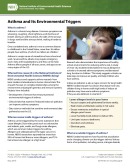
Asthma is a chronic lung disease. Common symptoms are wheezing, coughing, chest tightness, and shortness of breath. During an asthma attack, the sides of the airways in lungs swell and the airways shrink, making it harder to breathe.
Last Updated:
Autoimmune Diseases and Your Environment
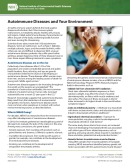
A healthy immune system defends the body against disease and infection. But if the immune system malfunctions, it mistakenly attacks healthy cells, tissues, and organs. Called autoimmune disease, these attacks can affect any part of the body, weakening bodily function and even turning life-threatening
Last Updated:
Breast Cancer: Why the Environment Matters
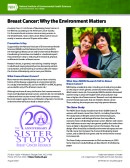
NIEHS plays a leadership role in funding and conducting studies on the ways in which genetic and environmental factors may affect a woman's chance of developing breast cancer. Understanding these factors presents tremendous opportunity for disease prevention.
Last Updated:
Cambio Climático Y Salud Humana
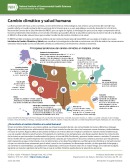
Si bien el cambio climático es un proceso global, conlleva repercusiones a nivel local y regional que pueden afectar a las comunidades. Cualquier persona puede verse perjudicada por el cambio climático en algún momento de su vida, sin importar dónde viva. El NIEHS dirige y coordina los esfuerzos del NIH (Institutos Nacionales de Salud, por sus siglas en inglés) para comprender mejor la manera en que el cambio climático puede afectar la salud de las personas.
Last Updated:
Cáncer De Seno: Por Qué Importa El Medio Ambiente
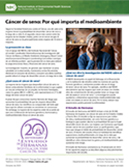
El NIEHS desempeña un papel de liderazgo en la financiación y realización de estudios sobre las formas en que los factores genéticos y ambientales pueden afectar la probabilidad de una mujer de desarrollar cáncer de seno. Comprender estos factores ofrece una gran oportunidad para la prevención de enfermedades.
Last Updated:
Cell Phone Radio Frequency Radiation Studies

Cell Phone Radio Frequency Radiation Studies
Last Updated:
Children’s Health – Why the Environment Matters
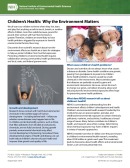
NIEHS is committed to understanding how the environment affects children’s development and health. Children’s environmental health research funded by the institute focuses on preconception, prenatal, and childhood environmental exposures to certain chemicals, pollutants, nutrients, and activities.
Last Updated:
Climate Change and Human Health
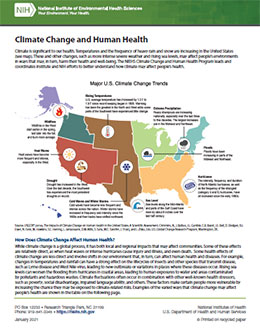
While climate change is a global process, it has both local and regional impacts that may affect communities. Every American may be vulnerable to the effects of climate change at some point in their lives, no matter where they live. NIEHS leads and coordinates NIH efforts to better understand how climate change may affect people’s health.
Last Updated:
Collaborative Centers in Children's Environmental Health Research and Translation
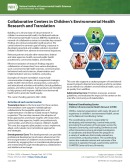
This network of collaborative centers translates key research findings into clinical and public health practice. Research translation products are intended to help protect and improve children’s environmental health and to promote health equity.
Last Updated:
Cosmetics and Your Health: NIEHS Research Findings
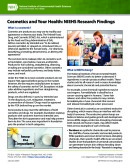
Millions of women and men around the world use cosmetics to enhance or change their appearance. The common term makeup refers to cosmetics such as foundation, eye shadow, eye liner, mascara, blush, and lipstick. Other cosmetics may include nail polish, body wash and moisturizers, perfumes, and hair coloring or styling products.
Last Updated:
Drinking Water and Your Health
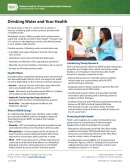
Drinking water in the U.S. comes from a variety of sources, including public water systems, private wells, or bottled water. Worldwide, nearly 2 billion people drink contaminated water that could be harmful to their health. Though more of a concern in developing countries, safe drinking water is a U.S. public health priority.
Last Updated:
El Asma Y Sus Desencadenantes Medioambientales
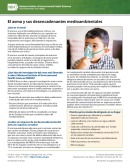
El asma es una enfermedad pulmonar crónica. Los síntomas habituales son sibilancias, tos, opresión en el pecho y falta de aire. Durante un ataque de asma, las paredes de los pulmones se inflaman y las vías respiratorias se encogen, dificultando la respiración.
Last Updated:
El Moho Y Su Salud
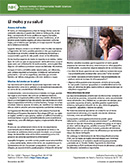
Siendo un microorganismo y tipo de hongo, el moho forma parte del ambiente natural y se puede encontrar en todas partes, en el exterior y en el interior. Las reacciones en las personas relacionadas con la salud dependen del tipo de moho, de la cantidad y la duración de la exposición, y de las características individuales.
Last Updated:
Electric and Magnetic Fields Associated with the Use of Electric Power: Questions and Answers (English)
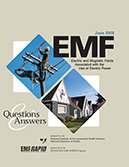
Since the mid-twentieth century, electricity has been an essential part of our lives. Electricity powers our appliances, office equipment, and countless other devices that we use to make life safer, easier, and more interesting. Use of electric power is something we take for granted.
Last Updated:
Endocrine Disruptors and Your Health
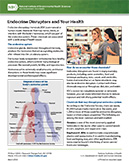
Endocrine disruptors are natural or human-made chemicals that may mimic or interfere with the body’s hormones, known as the endocrine system.
Last Updated:
Environment and Health A to Z
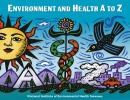
No two people live in the exact same environment. The SOIL beneath our feet, the AIR we breathe, and the WATER flowing through our pipes and waterways can all differ greatly, depending on where we live. On top of that, each of us eats different foods, shares our space with different plants and animals, and has access to different medicines and technology. NIEHS explores the connections between the environment and health, gathering scientific knowledge to help prevent human disease.
Last Updated:
Fellowship Grant Awards
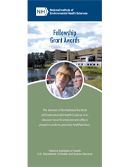
NIEHS offers a variety of Ruth L. Kirschstein National Research Service Award (NRSA) Individual Fellowships. These fellowship awards support full-time research training for predoctoral and postdoctoral students, as well as experienced scientists wishing to broaden their scientific background.
Last Updated:
Flame Retardants
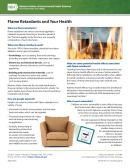
Flame retardants are various chemicals applied to materials to help prevent burning or slow the spread of fire. The term applies to the function, not a specific composition, of such chemicals.
Last Updated:
HHEAR Handout
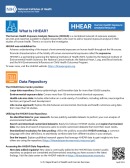
The Human Health Exposure Analysis Resource (HHEAR) is a centralized network of exposure analysis services and expertise available to eligible researchers who want to add or expand exposure analysis to their studies of human health.
Last Updated:
Integrated Chemical Environment (ICE) and Open Structure-activity/property Relationship App (OPERA)
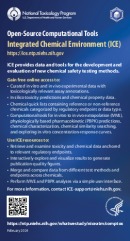
ICE provides data and tools for the development and evaluation of new chemical safety testing methods.
OPERA is a free and open-source quantitative structure-activity relationship (QSAR) tool.
Last Updated:
La Salud Pulmonar Y Tu Medioambiente
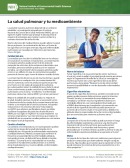
La salud de nuestros pulmones depende de un ambiente saludable. La investigación apoyada por el Instituto Nacional de Ciencias de la Salud Ambiental (NIEHS, por sus siglas en inglés) muestra que proteger la salud pulmonar requiere de estrategias para mejorar nuestro ambiente y nuestras elecciones de estilo de vida.
Last Updated:
Lead and Your Health
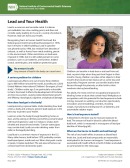
Any amount of lead in the body can harm your health. NIEHS supports research to find out who is affected by lead exposure and the range of health effects caused by lead.
Last Updated:
Lung Health and Your Environment
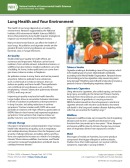
Research supported by NIEHS shows that protecting lung health requires strategies to improve our environment and lifestyle choices.
Last Updated:
Medio Ambiente Y Salud, De La A a La Z
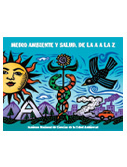
No hay dos personas que vivan exactamente en el mismo entorno. La tierra debajo de nuestros pies, el aire que respiramos y el agua que fluye a través de nuestras tuberías y vías fluviales pueden ser muy diferentes, dependiendo de dónde vivamos. Por si fuera poco, cada uno de nosotros come diferentes alimentos, comparte un mismo espacio con diferentes plantas y animales, y tiene acceso a diferentes medicamentos y tecnología.
Last Updated:
Microbiome
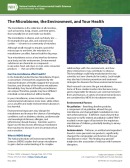
The microbiome is the collection of all microbes, such as bacteria, fungi, viruses, and their genes, that naturally live on and inside our bodies. The microbiome is diverse, and each body site, for example, the gut, skin, and oral and nasal cavities, is home to a community of microbes.
Last Updated:
Mold and Your Health
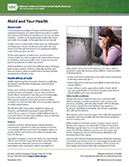
A microorganism and type of fungus, molds are part of the natural environment and can be found everywhere, outside and indoors. Health-related reactions in people depend on mold type, the amount and duration of exposure, and individual characteristics.
Last Updated:
National Institute of Environmental Health Sciences
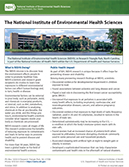
The National Institute of Environmental Health Sciences (NIEHS) is one of 27 institutes and centers of the National Institutes of Health (NIH), which is a component of the U.S. Department of Health and Human Services (HHS). NIEHS is located in Research Triangle Park (RTP), North Carolina.
Last Updated:
NIEHS Scholars Connect Program
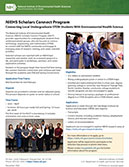
The NIEHS Scholars Connect Program provides opportunities for undergraduate students from underrepresented groups, who are focused on science, technology, engineering, and mathematics (STEM), to connect with the NIEHS community and engage in emerging areas of research, training, and career-oriented activities.
Last Updated:
NIEHS Strategic Plan 2018-2023 (Booklet)
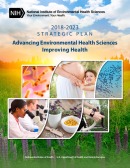
The mission of the National Institute of Environmental Health Sciences is to discover how the environment affects people in order to promote healthier lives.
Last Updated:
NIEHS Strategic Plan 2018-2023 (Tri-Fold)
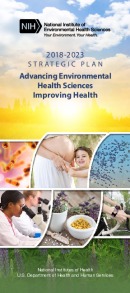
The mission of the National Institute of Environmental Health Sciences is to discover how the environment affects people in order to promote healthier lives.
Last Updated:
NIEHS Summer Internship Program
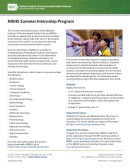
The Summer Internship Program at the National Institute of Environmental Health Sciences (NIEHS) provides an opportunity to spend a summer working at the institute, side by side with some of the leading scientists in the world, in an environment devoted exclusively to environmental health research.
Last Updated:
NIEHS Sustainability Report 2019
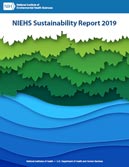
The Institute’s mission is to seek fundamental knowledge about the nature and behavior of living systems and the application of that knowledge to enhance health, lengthen life, and reduce illness and disability.
Last Updated:
NIH Disaster Research Response (DR2) Program
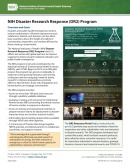
The National Institutes of Health Disaster Research Response (DR2) program leads U.S. efforts and works with global partners to improve capacity for timely research related to disasters and public health emergencies. NIEHS coordinates the program. Disasters and public health emergencies result in unique combinations of human exposures to toxic substances, hazards, and stressors; yet too often, basic questions about the health and safety of communities, responders, and workers affected by these events go unanswered.
Last Updated:
NTP Botanical Dietary Supplements Program
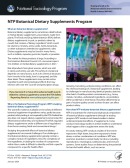
Botanical dietary supplements, sometimes called herbals or herbal dietary supplements, are products made from plants.
Last Updated:
NTP Chemical Effects in Biological Systems (CEBS)
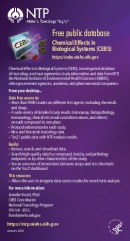
Chemical Effects in Biological Systems (CEBS), an integrated database of toxicology and toxicogenomics study information and data from NTP, National Institute of Environmental Health Sciences (NIEHS), other government agencies, academia, and pharmaceutical companies.
Last Updated:
NTP Nonneoplastic Lesion Atlas
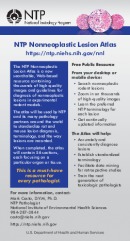
The NTP Nonneoplastic Lesion Atlas is a new searchable, Web-based resource containing thousands of high-quality images and guidelines for diagnosis of nonneoplastic lesions in experimental rodent models.
Last Updated:
Occupational Health: Why the Environment Matters
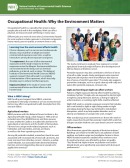
Occupational health is a specialty that strives to keep people safe and well in the workplace. Work can affect physical, mental, and social well-being in many ways.
Last Updated:
Overview: Training and Career Development Opportunities
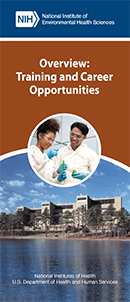
Developing a diverse biomedical workforce is an important part of the NIEHS mission to advance environmental health. To that end, NIEHS supports a wide range of high-quality internships, training, and career development opportunities.
Last Updated:
Partnerships for Environmental Public Health (PEPH)
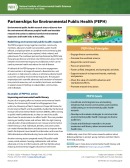
The PEPH program brings together scientists, community members, educators, health care providers, public health officials, and policymakers to coordinate environmental public health research at local, state, regional, tribal, national, and global levels.
Last Updated:
Postdoctoral Training at NIEHS
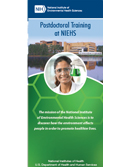
The National Institute of Environmental Health Sciences (NIEHS) is one of 27 institutes and centers of the National Institutes of Health, which is part of the U.S. Department of Health and Human Services. Unlike the majority of NIH institutes located in Bethesda, Maryland, NIEHS is located in Research Triangle Park, North Carolina, a major U.S. center of biotechnology and health research.
Last Updated:
Report on Carcinogens, The
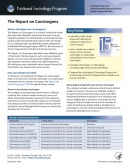
The Report on Carcinogens is a scientific and public health document that identifies substances that pose a cancer hazard for people in the United States. It is intended to help people make informed decisions about their own health.
Last Updated:
Reproductive Health in Females and Males
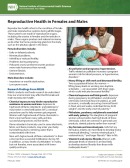
Reproductive health refers to the condition of female and male reproductive systems during all life stages. NIEHS conducts and funds research to understand how our environment may affect reproductive health.
Last Updated:
Scientific Director’s Traineeship for Inclusion, Diversity, and Equity (STrIDE)
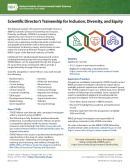
The Scientific Director’s Traineeship for Inclusion, Diversity, and Equity (STrIDE) is a paid training opportunity for postbaccalaureate, predoctoral, and postdoctoral trainees within the Intramural Research Program at NIEHS. Individuals from disadvantaged backgrounds and/or underrepresented groups are encouraged to apply.
Last Updated:
Superfund Research Program
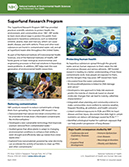
The Superfund Research Program (SRP) has provided practical, scientific solutions to protect health, the environment, and communities since 1987. SRP works to learn more about ways to protect the public from exposure to hazardous substances, such as industrial solvents, arsenic, lead, and mercury, which can cause death, disease, and birth defects. These and other toxic substances are found in contaminated water, soil, and air at Superfund waste sites throughout the United States.
Last Updated:
Systematic Review
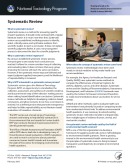
Systematic review is a method for answering specific research questions. It should not be confused with a regular literature search. It is much more than that. Systematic review uses a predefined, multistep process to identify, select, critically assess, and synthesize evidence from scientific studies to reach a conclusion.
Last Updated:
Tox21: Toxicology Testing in the 21st Century
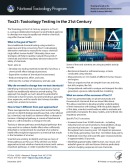
The Toxicology in the 21st Century program, or Tox21, is a unique collaboration between several federal agencies to develop new ways to rapidly test whether chemicals may affect human health.
Last Updated:
Worker Training Program
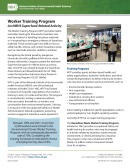
The Worker Training Program (WTP) provides health and safety training for thousands of workers who may be involved in handling hazardous materials or in responding to emergency releases of hazardous materials. These workers gain new skills on how to safely handle, remove, and contain hazardous waste, such as chemicals, asbestos, radiation, and lead.


